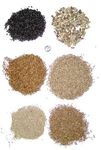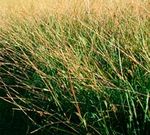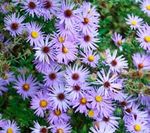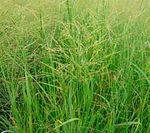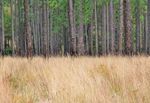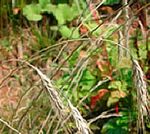For a Successful Native Grass and Forb Establishment - Expanded Edition - Now Includes the Coastal Plains
←
→
Page content transcription
If your browser does not render page correctly, please read the page content below
For a Successful Native Grass
and Forb Establishment
Randy Seymour, John Seymour
and Chris Blackford
Expanded Edition –
Now Includes the Coastal PlainsSix Basic Elements for a Successful Native Grass and Forb Establishment – Third Edition By Randy Seymour, John Seymour and Chris Blackford ©2008 Roundstone Native Seed, LLC
Roundstone Native Seed, LLC 3
Six Basic Elements for a Successful Native Grass
and Forb Establishment
1. Understand How Native Warm Season Grasses and Forbs Grow
Native Warm Season Grasses (NWSG)
are clump grasses, not turf grasses, as are
most of the forage grasses we are familiar
with. Please do not make the common
mistake of evaluating and managing
your NWSG planting based on your
experience with cool season turf
grasses that form dense mats.
NWSG plantings are slow to establish,
devoting most of their energy the first
year to developing a root system. Do
not expect to see a lush green carpet
and full ground cover the first year.
Keep in mind that these are clump
Forage planting at 90 days
grasses that spread by rhizomes, and a
single plant may be one to two feet in
diameter when mature. A single plant
every square foot will, in time, produce
a very good stand.
Using developed protocols for
establishment, it is possible to produce CRP planting at 45 days
harvestable first-year stands of some
NWSG for forage. Such forage plantings may require a seeding rate as high as
12 PLS pounds of seed per acre. A primary goal for CRP plantings, however,
is wildlife habitat and forage plantings are often too dense to provide ideal
habitat. For this reason CRP plantings use low seeding rates that may add to
the difficulty of establishment. The CRP CP-25 practices often use a rate as low
as 3 PLS pounds per acre of NWSG seed and other wildlife plantings. At this
extremely low rate it is imperative that every single seed possible germinate and
survive to insure a viable stand.
Be patient—it takes much longer to establish a stand of NWSG than it takes
to establish a stand of cool season grasses. What may look like a weed patch in
the first growing season can be a good stand. If in doubt, ask your DC, a Fish &
Wildlife-Resources biologist, or your seed producer.4 Six Basic Elements for a Successful Native Grass and Forb Establishment 2. Competition Control No single factor, with the possible exception of seeding depth, is as important to a successful establishment of NWSG as control of competition. NWSG and the forbs used in CRP plantings are slow to establish and cannot withstand shading or competition for moisture. These plants mostly devote their energy to putting down a root system the first year and if the minimal leaf area produced cannot get sunlight the plant will simply wither and die. Don’t, however, give up on your stand if you lose some plants due to shading, moisture competition, or drought. Most NWSG, forbs, and legumes have a high degree of dormancy and many seeds will not germinate the first year. Many native seeds, especially the forbs and legumes, need a cold-moist stratification, as is naturally provided by winter weather, to break dormancy. Additional seeds will germinate the next spring giving you a second chance to manage the competition. Know what weeds you are going to try to kill before you start The first and perhaps most important step in controlling competition is to take a botanical inventory of the establishment site. Determine what weed species are most likely to be present throughout the growing season before you start planning your competition control. When you know what weed species are going to be a problem you can choose a herbicide or combination of herbicides tailored to the specific competition. For example, weed species such as Dogbane, Sumac, Multiflora Rose, Bermuda Grass, Bahia Grass and many others are not effectively controlled by Roundup® alone. Other herbicides, such as Crossbow®, may be necessary for such hard to kill species. Imazapyr-based herbicide may be effective for Bermuda Grass and Bahia Grass. See your herbicide dealer for specific recommendations for your list of weed problems. Control of cool season weeds Control of cool season weeds and unwanted grasses is fairly simple. It is just a matter of choosing the right site preparation method, the right herbicide, and the right time of application. Ahead in this booklet you will find a recommended set of weed control practices. You will want as little remaining dead plant material on the establishment site at the time of seeding as is possible. Control of warm season weeds Control of warm season weeds and unwanted grasses is not so simple and is paramount to a successful establishment. The problem with the warm season weeds is that they do not emerge and their seeds do not germinate until about the same time or later than you will want to seed your NWSG and forbs. While you can effectively kill most growing warm season weeds and grasses, it is the unsprouted seeds of these competitors that will be your primary problem. The goal is to select and time your herbicide treatment for maximum killing effect and to include an effective pre-emergent herbicide that will suppress germination of these warm season competitor seeds.
Roundstone Native Seed, LLC 5
Weed Control & Site Preparation – Important!
Not properly controlling weeds and not preparing the site will
almost guarantee establishment failure.
Land cultivated after the first
herbicide treatment, bringing a
new crop of weed seeds to the
surface.
A single early burndown without
a pre-emergent burndown has
given the competition so much of
a head-start that it will smother
out the seedlings.
An example where only a single
burndown was made, but too late
to get a kill, leaving too much
vegetation to effectively drill
through.
Recommended process of weed control for a native warm season grass planting
Most CRP producers will not have the opportunity to follow this set of
guidelines in its entirety. Given the time of year and the extent of cost share
available you should apply as much of this recommendation as possible to
ensure competition control.
1. Herbicide treat warm season weeds and grasses such as Johnson Grass, Giant
Foxtail, Crabgrass, Texas Panicum, Pigweed, etc. prior to seed formation in the
year prior to establishment to prevent a weed seed crop from infesting your site6 Six Basic Elements for a Successful Native Grass and Forb Establishment
after seeding of the natives. If this is not possible, the use of a pre-emergent
herbicide with Imazapic as the active ingredient will suppress germination of
these warm season weed seeds until after your native plants have had a chance
to get started. Imazapic may impede growth in weak seedlings. In the Deep
South, where Bermuda Grass or Bahia Grass can be a major problem, a herbicide
containing Imazypryr can be used in late summer or fall. Check with your
supplier or NRCS for recommended rates.
2. In the fall prior to the establishment year remove as much vegetation and
thatch as possible from the site by burning, haying, grazing, or mowing.
Mowing is the least desirable method because of the residue left on the
ground. If this is not possible due to time or program restrictions in the fall,
then removal of thatch should be done in the spring. On steep slopes it maybe
advisable to not remove existing thatch until spring due to the potential for
erosion. Mowing should not be used in the spring due to the difficulty the
seed drill will have in cutting through the horizontal vegetation. Drills will do
a better job of getting the seed in the soil in standing vegetation than in newly
mowed vegetation and will avoid pressing thatch into the ground to wick
moisture away from the seed and preventing good seed to soil contact.
3. In the fall or spring following at least 6” of regrowth or new growth of the
dominant cool season plants, especially fescue, a selected herbicide should
be used for a complete burndown. Spring is preferred for this burndown due
to the need for vernal weed control, however, a fall burndown may be best
due to the difficulty of timely getting into wet fields in the spring to make the
herbicide treatment. If the site is a reasonably clean bean, corn, or other crop
field, a spring or fall herbicide burndown is probably not needed. Where a crop
field needs a cover crop to prevent
erosion, oats should be used instead
of wheat or rye, which produce an
allopathy that will prevent native
seeds from germinating. The oats
will need to be killed back in April.
4. Seven to ten days prior to seeding,
a combination herbicide treatment
should be applied. This herbicide
treatment should include a selected CRP Planting in a pasture field following effective
burndown herbicide to kill any competition control practices. Practices included
bush-hogging in the fall, a spring burndown, and
remaining cool season plants
a pre-emergent Roundup® burndown with an
surviving the early spring burndown Imazapic-based herbicide included to suppress
and any warm season plants that warm season seed germination.
have emerged prior to seeding. In
addition, this treatment, as needed, should include 2 to 4 ounces of an Imazapic-
based herbicide to suppress the germination of many warm season weed seeds.Roundstone Native Seed, LLC 7 3. SEEDING METHOD Most native warm season grass and most CRP recommended forbs and legumes will not emerge if planted below ¼” in depth. This needs repeating. They simply won’t sprout if planted too deep. The seeding method and equipment chosen must ensure really good seed to soil contact and prevent burying the seed too deep. For very sandy soils that quickly lose surface moisture, especially in the coastal plain, a compromise of seeding depth should be made to ensure moisture availability, especially late in the year. Native warm season grass species such as Big Bluestem, Little Bluestem, Wiregrass, and Indian Grass have long awns and hairy appendages that make the seed extremely light and fluffy. In addition, most of the seed on the market has been combined with a traditional combine and contains typically 20 to 40 percent chaff (stems and leaves). Seed that has not been debearded (had the awns and hairs removed) or that contains high percentages of inert matter (stems and leaves) MUST be planted with a specialty warm season no-till grass drill, which compensates for the light fluffy seed and trash with picker wheels for seed pickup and oversized tubes to reduce clogging. Even with the specialty drills, non- debearded seed and seed with a high chaff content will clog seed delivery tubes and will require constant monitoring Debearded seed with the chaff cleaned out can be run through a conventional drill or can be broadcast when special care is taken as will be explained later in this booklet. A possible exception to this is Little Bluestem, which can rarely be debearded completely without damaging the seed. Mixes with minor percentages of debearded Little Bluestem should be okay to run in a conventional drill with careful monitoring. We recommend the use of specialty warm season no-till drills even for debearded seed due to other features normally included that aid in accurate seed placement. With the extremely low CRP seeding rates it is critical that every seed possible be placed to maximize germination. Drilling warm season grass seed using warm-season specialty drills.
8 Six Basic Elements for a Successful Native Grass and Forb Establishment
The following drill features and operation suggestions will aid correct seed
placement:
• No-till drills need trash plows to provide a flat seed bed in exposed soil. Trash
plows cut through crowns of existing vegetation to allow placement of the
seed in soil rather than on top of roots and dead vegetation. In addition, the
trash plows level the soil in front of the double disc openers to aid inaccurate
seed depth placement. This can be especially important when drilling across
rows in crop residue fields.
• Excessive drilling speed
Agitator Screw & Picker Wheels
should be avoided when To ensure a dependable constant
using trash plows to measurement of seed delivery.
prevent throwing dirt
into the excavation made
by the adjacent plows.
Trash Plows
• Drills with depth To level planting area for depth
control and to scalp the site to
bands on the double insure seed to soil contact.
disc openers to
prevent placing seed
too deep are highly Depth Bands
recommended. A to prevent burying seed too deeply.
good rule of thumb for Seed buried deeper that ¼” will not
survive.
accurate seed depth
placement is to expect to
see about 1/3 of the seed
exposed on top of the
ground.
• Caution is urged to
ensure alignment of
trash plows, discs, and
packer wheels. The discs
should ride in the center of the trough cut by the trash plows and the packer
wheels must align with the groove cut by the coulters to effectively press the
seed into the soil.
• Caution is urged to ensure proper pressure settings for trash plows and
packer wheels. Do not cut with the trash plows any deeper than is absolutely
necessary to expose soil consistently. Make sure the packer wheels have
pressure on them.
• When drilling a mix of grasses and forbs where the seed has been debearded,
there is no problem in mixing the grass and forb seed together and drilling
all of it through the same box. It is recommended, however, that the seedRoundstone Native Seed, LLC 9 box only be filled to 2/3 capacity to compensate for any separation that might occur. When the seed is not debearded and the trash has not been cleaned out, it is recommended that the small smooth seed in the mix be run through the legume box and the larger smooth forb seed be run in the cool season box. Otherwise the smooth seed will settle to the bottom resulting in areas with no grass seed and areas with no forb seed. If you have purchased debearded seed with the chaff cleaned out and have elected to use a conventional seed drill or to broadcast seed your CRP contract, here area few suggestions that will help ensure a successful establishment: • Carefully calibrate the seeding rate on your drill and test the calibration over a large known area to ensure you do not exhaust your seed prior to seeding the contract area. Additional reduction gears will allow calibration with very close tolerances on most native warm season grass drills. • Check your seeding depth often and choose to err on the side of too shallow rather than too deep. • Inspect your seed delivery hoses often to keep them from clogging, especially if Little Bluestem or Side Oats Grama is included in the seed mix. • Do not attempt to broadcast seed on other than conventionally tilled ground. Cultipack the site prior to broadcast seeding and then cultipack again after seeding to firmly press the seed into the soil. Failure to cultipack prior to broadcast seeding will result in a large percentage of the seeds being placed too deep to germinate and has been a cause of numerous establishment failures. • When broadcasting, a carrier may be needed to evenly distribute the light grass seed, especially Little Bluestem and Side Oats Grama, as well as the heavier forb seed. It is best to broadcast at a half rate and seed over the area twice with the second pass at a right angle to the first pass. • Fertilizer is not recommended as a carrier. Your native grasses will not need the fertilizer in the first year and any addition of fertilizer will only give the competition a boost.
10 Six Basic Elements for a Successful Native Grass and Forb Establishment 4. TIMING AND RATE OF SEEDING Most native warm season grass seed and many of the forbs included in CRP mixtures will not germinate until the soil temperature is above 55°F. There is therefore little incentive to plant seed early and there are plenty of reasons to delay planting until the appropriate time. Keep in mind that the biggest cause of establishment failure is a failure to control competition. Often the most critical factor in reducing competition is to control warm season grasses and weeds. Like the natives you are trying to establish, these warm season grasses and weeds won’t germinate until the soil temperature is around 55°F. By waiting you will allow these warm season grasses and weeds to emerge so they can be effectively killed with your herbicide application. Planting too early also has the disadvantage of exposing your seed to erosion, predation, and becoming buried too deep for emergence. The danger in planting late is the increased possibility of reduced soil moisture. Generally, the optimum time for seeding NWSG seed in the southeastern United States is mid-May to mid-June. In the Deep South, seeding may begin as early as March 15. Two weeks earlier is okay if you are absolutely certain there will be no warm season grass and weed competition. In normal to moderately below normal moisture years successful plantings have consistently been completed as late as the last week in June. At these later dates it is even more important to eliminate competition for soil moisture. A wildlife habitat planting 12 months after seeding. This field was seeded on June 21 in a dry year.
Roundstone Native Seed, LLC 11 Fall or dormant seeding of NWSG should be avoided, especially with the very low seeding rates provided in the CRP practices. Fall seeding will result in seed too deep due to frost heaving, and there will be considerable seed loss due to erosion, predation and rot. Seeds germinating late in the fall risk being killed before sufficient root systems are established to withstand freezing. At 3 PLS pounds of seed per acre rates, you cannot expect a stand if you lose any seed. Very careful calibration of the specialty warm season drill is vital for correct seeding rates and is often difficult. Often these drills will not have the needed extra gears or have the adjustment mechanisms necessary to adjust the seed output in less than 1- or 2-pound increments. If borrowing a Fish & Wildlife Resources drill or renting one from a dealer, have the Dept. of Fish & Wildlife Resources personnel or the dealer calibrate the drill for your contract mix. Running out of seed prior to weeding the contract area and having to go back to the seed vendor for more seed is an expensive—and all-too-common—problem. Late winter (January-March) dormant seedings can be successful when prior- year competition has been carefully implemented. Dormant seeding in corn, bean, cotton or cereal crop fields that have been herbicide treated in anticipation of a dormant seeding can be very effective. Seeding rates for late winter dormant seedings should be increased by 25% to compensate for seed lost to rot, predators and frost heaving. Late winter dormant seedings have the advantage of subjecting the seed to a natural cold/moist stratification, and especially increases forb density in the first year.
12 Six Basic Elements for a Successful Native Grass and Forb Establishment
5. SEED QUALITY AND CONDITIONING
If your seed is no good, full of trash,
and contains lots of weed seeds, it
doesn’t matter how much care you
take in seeding your contract, how
hard you work to prepare your site,
or how much effort and expense you
put into controlling competition. You
simply won’t get a stand.
Do not let price alone be the
determining factor when purchasing
your seed. Shop wisely and don’t
be afraid to ask questions about the
seed you are about to purchase. Just
because a bag of seed has a tag on it
does not insure that what is on the
tag is what is in the bag.
Seed shipped out directly to
consumers evades any quality
inspection by state regulatory services
or any other agency designated to Quality seed is free of chaff and weed seed, and has
a current seed test showing Purity and Germination.
protect consumer interests. Such
practices create a dumping ground for old, mislabeled, and poor quality seed.
Seed industry analysts are reporting that low demand over the past few years
has resulted in large inventories of old seed stored in bins without heat and
moisture control.
Recommended considerations when purchasing seed for your CRP
contract
• Buy ecotype (locally adapted) seed if available. Ecotype seed evolved in
your soils, climate, rainfall, geology, and pests. It will simply perform much
better.
• Buy seed by PLS (pure live seed) weight and demand a current test. The
law requires a current test and any reputable dealer will comply.
• Demand to know the origin of seed purchased and the year produced.
Buy only current year production if available.
• Don’t buy seed with high percentages of inert matter (chaff). Such seed
will cause problems when drilling. In addition, if the producer cannot clean
the stems and grass out, then they cannot clean out the weed seeds.Roundstone Native Seed, LLC 13
• Examine the seed you purchased for weed and crop seed regardless of
what is printed on the tag.
• Buy seed that has been stored under temperature and humidity control.
Avoid seed that has been stored in grain bins through the hot summer.
• Buy only debearded seed if available. Only debearded seed can be cleaned
effectively. Debearded seed aids in seed to soil contact, won’t clog drills, and
provides approximately 15% more numbers of seed per PLS pound of seed
purchased.
• If in doubt about the quality of the seed you have purchased, send a
sample of the seed to your state regulatory services to be tested.
• Be sure to keep a sample for your records. In case of failure, a test can
quickly determine if the seed is at fault. Some programs will partially cost-
share replanting if an act of nature is the cause of failure rather than seed
quality.
Using high quality cleaned and conditioned seed pays.14 Six Basic Elements for a Successful Native Grass and Forb Establishment 6. Stand Maintenance Experience has shown that for many CRP producers that use quality seed, prepare their site, and use effective pre-emergent competition control, there is still the challenge of post-emergent weed control. Mowing can be an effective method of competition control; care must be taken, however, to ensure that mowing height is above emerging native grasses and forbs. Some of the forbs and legumes such as Partridge Pea and Blackeyed Susan in the CRP mixes are annuals or short lived biennials and are dependent on first-year seed production to maintain their presence. Mowing too late in the season to allow regrowth and seed production can destroy these plants from your stand. A major disadvantage to mowing is that it does not kill plants such as Johnson Grass, leaving the roots to reinfest your stand in the future. In areas where weeds or undesirables tower above the native plants, wicking has proven to be an effective and relatively inexpensive treatment. A rope wick applicator functions like a sponge mop, absorbing and holding the herbicide. The chemical is then wiped directly onto the weed. Rope wick applicators are available in hand-held, 4-wheeler-mounted and tractor-mounted models. NRCS personnel in some states* had the forethought to develop CRP mixes designed to be Imazapic herbicide tolerant, at least to some degree. Imazapic herbicides may burn some of the forbs and legumes rather badly but will not kill them except at very high rates. Applications of Imazapic will control most problems weeds and unwanted grasses, however, it is a selective herbicide and will not kill problem plants. The following are tips for using Imazapic herbicide based on our experience; you should, however, confirm with the manufacturer to make sure they will stand behind the products when following these tips: • Never apply Imazapic herbicide until all seedlings have 6” to 8” tall. • The use of Imazapic in early summer of the second year will take care of most weed problems where seed mixes were designed to be tolerant; most programs, however, are not designed to reimburse for this second treatment. • Do not use a surfactant in post-emergent applications or in first-year stands. • Post-emergent applications should be at 6 ounces per acre or less. Avoid using direct applications of broadleaf herbicides such as 2-4D to prevent killing of forbs and legumes in your CRP mix. Herbicide applications, even using broadleaf herbicides, have been effective using a wick applicator above emerging native grasses and forbs. Long-term maintenance of your CRP contract may include *This may not have been done in your state. Check the Plateau® label before using on the specific forbs in your mix.
Roundstone Native Seed, LLC 15 If possible, fire should be a part of your long-term maintenance planning. mowing, strip discing, and/or burning. Remember, these plants evolved dependent on fire and any effective management plan should include, if possible, periodic use of prescribed burns.You should discuss this maintenance option with your DC or Fish & Wildlife Resources representative. If you plan to use fire as a maintenance method, you should plan for a fire lane around your fields at the time of establishment. Fire lanes should be planted in a specific mix of species that will be green and resist burning in April when most controlled burns are performed. Planting fire lanes in White Clover or Winter Wheat are good options. Fire lanes can also be very effective wildlife food plots when managed.
16 Six Basic Elements for a Successful Native Grass and Forb Establishment Commonly Used Native Grasses and Wildflowers Big bluestem • Andropogon gerardii Eastern gamma grass • Trypsacum dactyloides Indian grass • Sorghastrum nutans Little bluestem • Schizachyrium scoparius Side-oats grama • Bouteloua curtipendula Switchgrass • Panicum virgatum
Roundstone Native Seed, LLC 17 Virginia wild rye • Elymus virginicus Purple top • Tridens flavus Wiregrass • Aristida stricta Pineywoods dropseed • Sporobolus junceus Toothache grass • Ctenium aromaticum Lopsided indian grass • Sorghastrum secundum
18 Six Basic Elements for a Successful Native Grass and Forb Establishment Blackeyed susan • Rudbeckia hirta False sunflower • Heliopsis helianthoides Greyheaded coneflower • Ratibida pinnata Partridge pea • Cassia fasciculata Purple coneflower • Echinacea purpurea Bergamot • Monarda fistulosa
Roundstone Native Seed, LLC 19 New England Aster • Aster novae-angliae Illinois Bundleflower • Desmanthus illinoensis Roundheaded lespedeza • Lespedeza capitata Butterfly milkweed • Asclepias tuberosa Rigid goldenrod • Solidago rigida Spiked blazing star • Liatris spicata
20 Six Basic Elements for a Successful Native Grass and Forb Establishment Hairy lespedeza • Lespedeza hirta Sensitive briar • Mimosa quadrivalvis Rattlesnake master • Eryngium yuccifolium Lance leaved coreopsis • Coreopsis lanceolata Wild senna • Cassia marilandica Florida tick trefoil • Desmodium floridanum
NATIVE GRASSES
Common Name Botanical Name Planting Rates Seeds / lb. Planting Flowering Period Soil Height
(PLS lbs / acre) Dates Moisture
Big Bluestem Andropogon gerardii 5 - 8 lbs 144,000 May - June August - October med - dry 6 - 8 ft.
Bottlebrush Grass Elymus hystrix N/A 75,000 May - June June - August med - dry 2.5 - 5 ft.
Broomsedge Andropogon virginicus 6 - 8 lbs 800,000 May - June August - October dry 1.5 - 3 ft.
Roundstone Native Seed, LLC
Canada Wild Rye Elymus canadensis 8 - 10 lbs 115,000 May - June June - August med - dry 3 - 5 ft.
Deer Toungue Grass Panicum clandestinum 3 - 5 lbs 350,000 May - June June - July dry - wet 2 - 3 ft.
Eastern Gamma Grass Tripsacum dactyloides 10 - 12 lbs 7,200 May - June Late June med - wet 8 - 10 ft.
Fall Panicum Panicum Anceps 8 - 10 lbs N/A May - June July - October dry - wet 3 - 4 ft.
Indian Grass Sorgahastrum nutans 8 - 10 lbs 170,000 May - June June - July med - dry 3 - 5 ft.
Little Bluestem Schizachyrium scoparium 6 - 8 lbs 250,000 May - June August - October med - dry 1.5 - 3 ft.
Purple Top Triden flavus 15 - 20 lbs 460,000 May - June August - October dry 2.5 - 3 ft.
River Bank Wild Rye Elymus riparius 8 - 10 lbs 125,000 May - June June - August wet 3 - 4.5 ft.
Side Oats Gramma Bouteloua curtipendula 3 - 5 lbs 135,000 May - June May - June med - dry 1.5 - 3 ft.
Switchgrass (Alamo) Panicum virgatum 6 - 8 lbs N/A May - June August - September med - dry 4 - 7 ft.
Switchgrass (Cave-in-Rock) Panicum virgatum 8 - 10 lbs 260,000 May - June July - September med - dry 4 - 6 ft.
Tall Dropseed Sporobulus compositus 6 - 8 lbs 760,000 May - June August med - dry 2 - 4 ft.
Virginia Wild Rye Elymus virginicus 8 - 10 lbs 100,000 May - June May - June med -wet 2 - 3 ft.
2122 Six Basic Elements for a Successful Native Grass and Forb Establishment
NATIVE WILDFLOWERS
Common Name Botanical Name Duration Flowering
Period
Bergamot Monarda fistulosa perennial July - August
Blackeyed Susan Rudbekia hirta perennial June - September
Blue False Indigo Baptisia australis perennial June - July
Butterfly Milkweed Asclepias tuberosa perennial June - August
False Sunflower Heliopsis helianthoides perennial June -August
Greyheaded Coneflower Ratibida pinnata perennial June - July
Illinois Bundleflower Desmanthus illinoensis perennial July - August
Iron Weed Veronica altissima perennial July - September
Joe Pye Weed Eupatorium fistulosum perennial August - September
Lance Leaved Coreopsis Coreopsis lanceolata perennial June - July
Maximilian Sunflower Helianthus maximilianii perennial August - September
New England Aster Aster novae-angliae perennial September - October
Partridge Pea Cassia fasciculate annual July - August
Prairie Dock Silphium pinnatifidum perennial July - September
Purple Coneflower Echniacea purpurea perennial June - July
Purple Prairie Clover Dalea purpureum perennial June - July
Rattlesnake Master Eryngium yuccifolium perennial July - August
Rigid Goldenrod Solidago rigida perennial August - October
Roundheaded Lespedeza Lespedeza capitata perennial August - September
Showy Tickseed Bidens aristosa annual August - September
Smooth Aster Aster laevis perennial September - October
Spiked Blazing Star Liatris spicata perennial July - August
Tall Coreopsis Coreopsis tripteris perennial July - September
White Wingstem, Verbesina virginica perennial August - October
Wild Quinine Parthenium integrifolium perennial July - August
Wild Senna Cassia marlandica perennial July - AugustRoundstone Native Seed, LLC 23 Color Height Soil Moisture Seeds / lb Seeding Rate Lavender 3 - 4 ft. moist - dry 1,250,000 2.5lbs /ac Yellow 1 - 3 ft. moist - dry 1,600,000 2.0 lbs/acre Blue 3 - 4 ft. med. - dry 26,000 25.0 lbs/acre Orange 1 - 3 ft. moist - med. 56,000 25.0 lbs/acre Yellow 3 - 7 ft. moist - dry 105,000 10.0 lbs/acre Yellow 3 - 4 ft. moist - dry 450,000 6.0 lbs/acre White 3 - 5 ft. moist - dry 200,000 10.0 lbs/acre Purple 3 - 7 ft. moist - dry 320,000 8.0 lbs/acre Pink 4 - 7 ft. moist - med. 120,000 7.5 lbs/acre Yellow 1 - 2 ft. med. - dry 220,000 5.5 lbs/acre Yellow 4 - 8 ft. moist - dry 210,000 4.0 lbs/acre Purple 2 - 4 ft. moist - med. 1,200,000 2.0 lbs/acre Yellow 2 - 4 ft. med. - dry 75,000 16.0 lbs/acre Yellow 4 - 8 ft. med. - dry 10,000 22.0 lbs/acre Lavender 2 - 3 ft. med. - dry 115,000 12.0 lbs/acre Pink 1.5 - 2 ft. med. - dry 290,000 8.0 lbs/acre Green 2 - 4 ft. med. - dry 128,000 10.0 lbs/acre Yellow 3 - 5 ft. med. - dry 730,000 3.0 lbs/acre White 3 - 4 ft. med. - dry 160,000 11.0 lbs/acre Yellow 2 - 3 ft. moist - med. 130,000 N/A Blue 2 - 4 ft. med. - dry 750,000 3.5 lbs/acre Pink 2 - 4 ft. moist - med. 100,000 10.0 lbs/acre Yellow 3 - 8 ft. moist - dry 170,000 5.0 lbs/acre White 3 - 7 ft. moist - med. N/A N/A White 2 - 3.5 ft. moist - dry 110,000 20.0 lbs/acre Yellow 3 - 6 ft. moist - dry 26,000 16.0 lbs/acre
9758 Raider Hollow Road, Upton, Kentucky 42784 270.531.3034 phone 270.531.3036 fax Chris@roundstoneseed.com John@roundstoneseed.com Randy@roundstoneseed.com www.roundstoneseed.com A Partner of
You can also read




